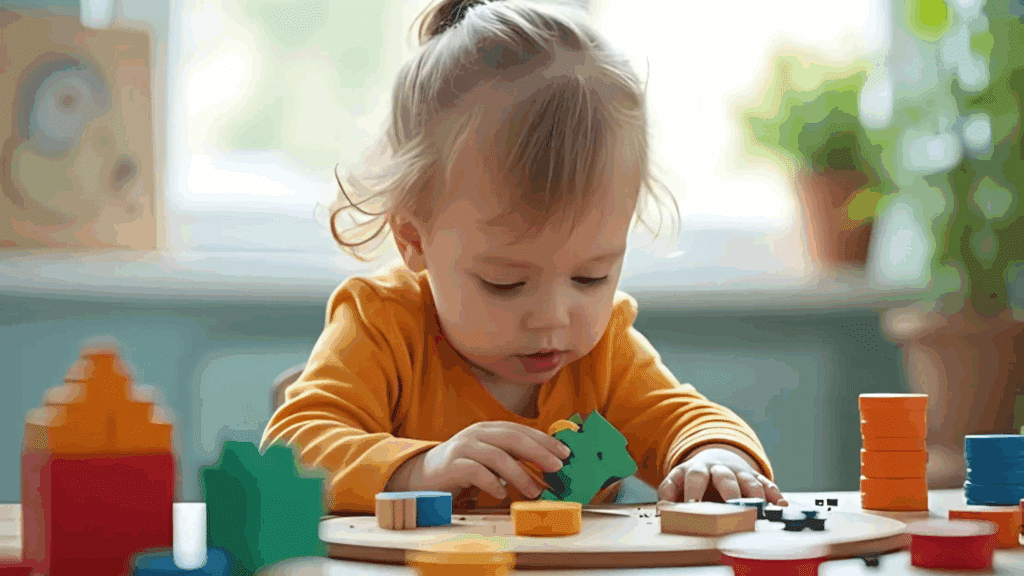Want to help a child catch a ball without fumbling? It’s a common concern.
While some kids string beads or cut with scissors with ease, others seem to struggle, and it can turn simple tasks into daily challenges.
Often, children who appear “clumsy” just need the right activities to build coordination between their eyes and hands. The best part? Many of the tools are already at home.
Professionals have worked with kids who had trouble holding a pencil or pouring juice without spilling. The solution isn’t pricey toys. It’s using everyday moments as chances to grow key skills.
Why Encourage Eye Hand Coordination Fine Motor Activities in Kids?
Eye-hand coordination fine motor activities are essential because they build the foundation for many daily skills children need as they grow.
From holding a pencil to tying shoelaces, these tasks require the hands and eyes to work together smoothly.
When kids engage in playful fine motor activities, they’re not just having fun; they’re also developing important control, focus, and strength.
Encouraging these movements early helps children:
- Build confidence in handling objects and tools.
- Improve school readiness through better writing and drawing ability.
- Enhance independence in dressing, feeding, and other self-care tasks.
These fun, simple exercises set kids up for success, making everyday life easier and more enjoyable.
Boost Skills with These Fun Eye Hand Coordination Fine Motor Activities

These eye hand coordination fine motor activities are perfect for helping kids improve control, focus, and confidence.
Using simple tools and playful tasks, little hands get stronger and more precise. Ideal for both at-home fun and early learning support.
1. Beading
Threading small beads onto a string strengthens finger muscles, improves focus, and enhances coordination between the eyes and hands.
Best for: Preschoolers
2. Lacing Cards
Children thread a shoelace or string through holes around a card, improving fine motor control and bilateral coordination.
Best for: Toddlers and preschoolers
3. Playdough Molding
Squishing, rolling, and shaping playdough helps build hand strength and finger control while also encouraging creativity.
Best for: Toddlers
4. Cutting with Scissors
Using child-safe scissors to cut paper or shapes helps children develop hand strength, precision, and confidence.
Best for: Preschoolers and older kids
5. Buttoning Practice
Practicing with real buttons or button boards teaches finger dexterity and supports dressing skills for independence.
Best for: Toddlers and preschoolers
6. Zipping and Unzipping
Zipping jackets, pencil cases, or zipper toys build coordination and help children master everyday self-care tasks.
Best for: Preschoolers
7. Puzzles
Fitting pieces into place encourages problem-solving and develops strong hand-eye coordination and spatial skills.
Best for: Toddlers and up
8. Sorting Small Objects
Sorting beads, pom-poms, or buttons by color or size boosts pincer grasp and improves focus and fine motor accuracy.
Best for: Toddlers
9. Sticker Play
Peeling and placing stickers on paper or surfaces enhances finger strength and precision while being fun and creative.
Best for: Toddlers and preschoolers
10. Peg Boards
Placing pegs into tiny holes improves finger control, concentration, and visual tracking.
Best for: Preschoolers
11. Tweezers or Tongs Games
Picking up small objects with tweezers or tongs strengthens the hands and improves accuracy and control.
Best for: Preschoolers
12. Drawing and Coloring
Using crayons or markers builds pencil grip, wrist control, and creative expression.
Best for: All ages
13. Tracing Shapes
Tracing over shapes or lines with pencils or fingers helps improve writing readiness and coordination.
Best for: Preschoolers
14. Building with Blocks
Stacking or connecting blocks requires control, balance, and planning, which helps build motor planning skills.
Best for: Toddlers and preschoolers
15. Threading Pasta
Stringing dry pasta on yarn strengthens fine motor coordination and encourages focus and creativity.
Best for: Toddlers
16. Sensory Bins
Digging, pouring, and finding objects in a bin of rice, beans, or sand improves tactile skills and coordination.
Best for: Toddlers
17. Crumpling Paper
Squeezing paper into balls or shapes helps build grip strength and control in a simple, fun way.
Best for: Toddlers
18. Tearing Paper
Ripping paper into strips or pieces helps strengthen fingers and teaches hand control.
Best for: Toddlers
19. Squeezing Sponges
Soaking and squeezing water from sponges strengthens hand and finger muscles and can be used in playful water games.
Best for: All ages
20. Using an Eye Dropper
Transferring colored water between cups with an eye dropper improves precision and control.
Best for: Preschoolers
21. Pipe Cleaner Threading
Threading pipe cleaners through holes or beads promotes patience, accuracy, and hand control.
Best for: Preschoolers
22. Chalk Drawing
Drawing with chalk on sidewalks or chalkboards supports grip strength and encourages large motor movement.
Best for: Toddlers and preschoolers
23. Finger Painting
Spreading paint with fingers is fun and supports sensory play, control, and early writing skills.
Best for: Toddlers
24. Using Clothespins
Pinching and clipping clothespins helps build strong finger muscles and improves pincer grip.
Best for: Preschoolers
25. Poking Holes in Paper
Using a stick, pencil, or safe poking tool to make holes builds hand strength and eye-hand coordination.
Best for: Preschoolers
26. Scooping and Pouring
Using spoons to scoop and transfer items like beans or rice improves focus and hand control.
Best for: Toddlers
27. Building with LEGO
Snapping LEGO bricks together builds finger strength, coordination, and creative thinking.
Best for: Preschoolers
28. Water Painting
Using a brush and water to “paint” on a surface builds control without mess, great for early learners.
Best for: Toddlers
29. Sponge Painting
Dabbing paint with a sponge helps strengthen hand muscles and explore textures.
Best for: Toddlers
30. Opening Containers
Twisting or snapping open plastic containers teaches wrist rotation and control.
Best for: Preschoolers
31. Tying Shoelaces
Learning to tie shoelaces supports finger strength, independence, and sequencing skills.
Best for: Older preschoolers
32. Weaving Paper
Weaving paper strips over and under helps with pattern recognition and bilateral coordination.
Best for: Preschoolers
33. Using a Hole Punch
Punching holes in paper with a hand punch strengthens grip and builds hand endurance.
Best for: Preschoolers
34. Transferring with Spoons
Moving objects from one bowl to another using spoons builds precision and patience.
Best for: Toddlers
35. Popping Bubble Wrap
Popping the bubbles is fun, sensory-rich, and great for developing finger strength.
Best for: All ages
36. Making Bracelets
Creating bracelets with beads and string improves fine motor control and creativity.
Best for: Preschoolers
37. Sticker Lines
Placing stickers along a drawn line improves accuracy and visual-motor skills.
Best for: Toddlers
38. Using a Whisk
Whisking water or batter strengthens arm and hand coordination during pretend play or cooking.
Best for: Preschoolers
39. Scooping Ice
Using scoops to move ice cubes encourages control and problem-solving through play.
Best for: Toddlers
40. Taping Lines
Lining up tape on paper or the floor develops spatial awareness and control.
Best for: Preschoolers
41. Using a Pipette
Using pipettes to move liquids strengthens finger pressure and coordination.
Best for: Preschoolers
42. Bubble Blowing
Blowing bubbles and popping them builds control, timing, and bilateral movement.
Best for: Toddlers
43. Sorting Coins
Sorting coins by size or type builds finger control and introduces math skills.
Best for: Preschoolers
44. Making Collages
Cutting, placing, and gluing small pieces to paper builds motor planning and precision.
Best for: All ages
45. Using Velcro Boards
Attaching and pulling Velcro pieces helps build grip and finger strength.
Best for: Toddlers
46. Spraying Water
Squeezing a spray bottle works on hand muscles and is a fun, interactive task.
Best for: Preschoolers
47. Balloon Volleyball
Tapping a balloon back and forth develops reaction time and hand-eye coordination.
Best for: All ages
48. Building with Magnets
Attaching and moving magnetic shapes helps with coordination and creativity.
Best for: Preschoolers
49. Mini Hammering
Using a toy hammer with pegs improves control, rhythm, and hand strength.
Best for: Toddlers
50. Using a Turkey Baster
Squeezing and releasing a baster in water strengthens hand muscles and is sensory-friendly.
Best for: Preschoolers
51. Making Paper Chains
Looping and gluing paper strips into chains builds focus and finger strength.
Best for: Preschoolers
52. Paper Tearing Art
Ripping colored paper and gluing it into shapes builds coordination and creative expression.
Best for: Toddlers and preschoolers
Tips to Improve Hand-Eye Coordination in Kids
Children typically begin developing hand-eye coordination around 4 to 6 months, when they start reaching for objects. By age 2-3 years, this skill continues to improve, allowing for more complex tasks like stacking blocks or drawing.
- Engage in Simple Ball Activities: Start with basic games like throwing, catching, or bouncing a ball to improve coordination.
- Play with Puzzles: Use puzzles (large pieces for younger kids, smaller for older) to help them match movements with visual cues.
- Use Art & Craft Activities: Activities like coloring, cutting with scissors, or stamping strengthen fine motor skills and hand-eye coordination.
- Introduce Fine Motor Toys: Toys like building blocks, Lego sets, or pegboards are great for developing coordination and visual assessment.
- Encourage Outdoor Play: Physical activities like catching, kicking a ball, or jump rope help synchronize movements with visual input.
- Use Sensory Play: Activities like playing with playdough, slime, or water pouring games help children develop both fine motor skills and coordination.
Bottom Line
The more kids practice eye hand coordination fine motor activities, the stronger their hands and eyes work together.
Over time, tasks like holding a pencil, using scissors, or feeding themselves become easier and more fun.
These small daily efforts can lead to big wins in confidence and independence. Keep things playful, be patient, and enjoy watching their progress grow.
Got any favorite eye-hand coordination, fine motor activities, or tips to share? Please drop a comment below, or let us know your thoughts and experiences.


















